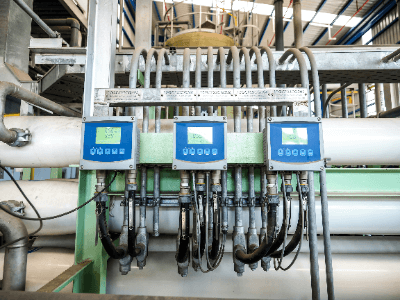What Is a Water Quality Measuring Instrument?
 Water quality measuring instruments are used to measure the contamination of general environmental water, industrial wastewater, oceans, lakes, rivers, and so on.
Water quality measuring instruments are used to measure the contamination of general environmental water, industrial wastewater, oceans, lakes, rivers, and so on.
Tap water, rivers, factory wastewater, etc. must meet specified standards for use and discharge, and the specified items vary depending on the purpose of use. Water quality measuring instruments are used to measure the specified test items. In addition to simple instruments, there are also instruments that specialize in a single measurement item and are used for purposes other than water quality testing, as well as instruments that specialize in multiple items of water quality testing.
In the 1950s, industrialization and urbanization caused pollution from wastewater. Therefore, wastewater discharged by business operators that does not conform to the standards is strictly prohibited, and the recording and preservation of inspection results is also mandatory.
Uses of Water Quality Measuring Instruments
Living organisms and water are closely related, including tap water, rivers, lakes, factory wastewater, swimming pools, hot spring facilities, and septic tanks. From the drinking water that humans consume to wastewater, from use to disposal, is controlled.
The reason why standards are required not only for what people take into their bodies but also for wastewater is that water is circulating. Pollution in rivers and groundwater is released into the atmosphere through evaporation, and after being purified, is returned to people as drinking water.
When water is stored in a cistern, such as in an apartment building, the cistern must be managed by the building owner. When cleaning the cistern and inspecting the management of the cistern water supply, or for cisterns with a capacity of 10 m3 or more, the color, odor, turbidity, and taste must be tested daily, and the residual chlorine must be tested once a week. Water service providers are required by the Water Supply Law to test 51 items of tap water.
Principle of Water Quality Measuring Instruments
Specific examples of measurement items are listed below.
- pH
The pH is measured in consideration of the effect of wastewater on aquatic organisms. Acidic wastewater corrodes sewage treatment facilities, and at power generation facilities, pH is controlled to keep the water alkaline to prevent corrosion of boiler pipes. In addition, in sewage treatment, it can be used to control the pH suitable for treatment in processes using bacteria or surfactants. - DO (Dissolved Oxygen)
DO stands for Dissolved Oxygen and refers to the concentration of dissolved oxygen in water. It is used as an indicator of pollution in rivers and lakes. In septic tanks and sewage treatment, it is measured in the process using activated sludge. - Conductivity
This is an indicator of the ease of electricity flow and measures the ions that carry electricity. - TOC
TOC stands for Total Organic Carbon and is an indicator of organic pollution. - Residual Chlorine
This is the effective chlorine that remains after disinfection or decomposition. It is measured in the control of chlorine concentration. - Turbidity
Turbidity is an indicator of the degree of turbidity. - Chromaticity
Chromaticity is an indicator of color degree. - Nitrogen, phosphorus
In closed water bodies (lakes, marshes, bays), nitrogen and phosphorus cause algae growth and are measured in wastewater to maintain the environment. - Ammoniacal Nitrogen
It is generated in the process of decomposition and decomposition of organic matter such as human waste, sewage, and industrial wastewater, and is an indicator of water pollution. - COD
COD is an abbreviation for Chemical Oxygen Demand, and is generally used to measure oxidizable substances in water as an indicator of pollution by organic matter.
Types of Water Quality Measuring Instruments
There are various types of water quality measuring instruments. These include moisture meters, conductivity meters, pH meters, refractometers, and residual chlorine meters.
Simple kits that can easily measure residual chlorine and pH are often used in swimming pools and hot spring facilities. Water quality testing kits for daily drinking can measure residual chlorine, pH, turbidity, color, conductivity, etc.
How to Choose a Water Quality Measuring Instrument
1. Electric Water Meter
Electric moisture meters can measure water in paper, wood, mortar, and other materials. Since each material has a unique electrical resistance value, the electrical resistance can be used to measure the water content in the material.
2. Conductivity Meter
Conductivity meters measure the ease with which electricity flows. It can be used to check the quality of water in rivers and lakes as well as to control pure water and boiler water.
3. Refractometer
Refractometers use the refraction of light to measure the concentration of solutions and include densitometers and saccharimeters. A few drops of sample are dropped onto a prism surface and checked through an eyepiece.
4. Residual Chlorine Meter
Residual chlorine meters can measure the residual chlorine concentration in tap water, cooking water, swimming pools, and bathhouses. The water is disinfected by chlorine-based chemicals and is measured for confirmation.
5. pH Meter
The pH meter can measure the properties of aqueous solutions, such as acidity and alkalinity. pH measurement is necessary to control the chemical properties of substances and chemical reactions.